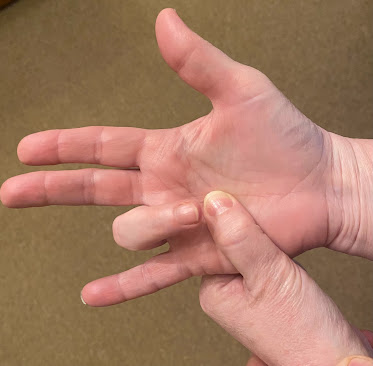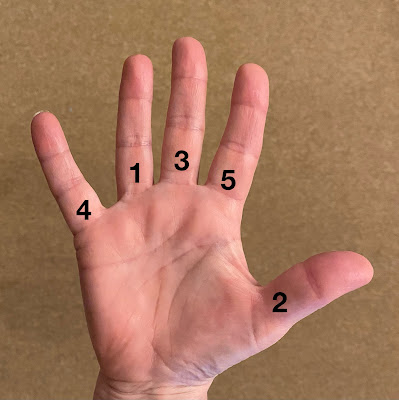By Stephen Bunting, Specialist MSK Physiotherapist (UK)
This article is about trigger digits, more commonly known as trigger finger or trigger thumb. Its main aim is to provide information and advice about the condition with an emphasis on self help. The information is also provided in video format below.
The article is written on the assumption that the reader has been diagnosed with trigger digit(s) by a health care professional. If you haven't been diagnosed but you think you might have the condition then its best to get checked out first as there are other conditions that can cause similar symptoms.
The article addresses trigger digits by answering the 3 most common questions that people ask after they have been diagnosed.
1) What is a Trigger Digit?
A person with triggering will say that their finger or thumb will occasionally stick down when they bend it. It most commonly occurs first thing in the morning and they might wake up with their finger or thumb locked into into their palm.
 |  |
The finger or thumb will then snap suddenly back out again when they try to straighten it or they might have to force it to straighten by using their other hand, and it will usually release suddenly. It can sometimes be painful when it straightens out suddenly and they will commonly feel a sudden click or a pop.
It's this sudden unlocking or triggering of the finger/thumb that gives the condition its common name. If the problem worsens then it can start happening more frequently throughout the day and eventually the triggering can happen every time the digit is bent.
 |
| A locked trigger finger |
A locked trigger finger will stiffen up very quickly and can take a long time to recover its movement. Sometimes it will never straighten again fully despite lots of hard work with the physios.
And so the main message is ... If you have a locked trigger finger or thumb that you can no longer straighten, then you need quick treatment, usually an injection. If the locked digit doesn't then straighten within a week or so then urgent surgery may be needed. So don't delay in getting seen.
 |
| The order of affected digits |
Trigger finger is essentially a mechanical problem involving one of the tendons in the affected digit. It's commonly called trigger finger but its also very common in the thumb. In fact in order of occurrence, it most commonly affects the ring finger, followed by the thumb, then the middle finger, the little finger and least of all the index finger. It's also more common in the dominant hand.
In order to understand what happens in a trigger finger, we first need to understand some basic anatomy. As you can see in the diagram below, we have a series of bones connected by joints that can each move in order to allow the finger to bend.
 |  |  |  |
What causes the bending movement is the flexor tendon which runs along the palm side of the finger. It's controlled by muscles in the forearm which pull the tendon and causes the finger to bend. The tendon is anchored to the joints by a series of pulleys, of which there are 5 main ones which we call the A1, A2, A3, A4 and A5 pulleys.
 |
| Pulleys working in a normal finger |
 |
| 'Bow-stringing' without Pulleys |
Occasionally a small swollen nodule can develop on the tendon which stops it from gliding smoothly through the pulleys and causes the classical triggering. When bending the finger the nodule will push up against the pulley but because the flexor tendon is so strong, it will usually be forced through but then get stuck on the other side as the weaker extensor tendons can't force it back through the other way.
 |
| Site of tenderness for ring finger and thumb triggering |
The other scenario we sometimes see is where the nodule is too large to enter the A1 pulley in the first place and therefore the finger won't bend properly. This usually occurs as a progression of the typical symptoms, so you might have experienced the usual triggering but then one day you notice that the finger stiffens and won't bend fully. The triggering therefore stops but you can't bend the finger. This is another type of locked finger, and you should get it seen quickly in order to avoid long term finger stiffness.
2) Why have I got it?
Trigger digit is a common condition. Studies report a prevalence of 2-3% in the general population. The condition has nothing to do with osteoarthritis or other degenerative conditions, it's just a simple mechanical problem causes by localised tendon swelling.
We know that it is more common in people over 50. It’s also more common in people with jobs or hobbies involving repetitive finger movements. It's also much more common in diabetics, where the prevalence increases to around 10% of the diabetic population.
People with inflammatory arthritis, such as Rheumatoid arthritis, gout and thyroid disease also have a higher risk of developing the condition. Other than that though, we don't really know what causes the tendon nodules to occur, but thankfully its an easy condition to treat and get better, which leads us onto the next question.
3) What can I do about it ?
If your finger or thumb is triggering fairly typically like we discussed earlier, meaning that its not locked and you are able to bend and straighten it out, even if just for a while and with some pain, then the chances are that it will usually respond to non-surgical treatment.
Medication
The usual self help remedy is to apply anti-inflammatory gel to the area around the tender nodule on the palm, 4 times daily with last application being just before going to bed.
Anti-inflammatory tablets can also be used but please consult a pharmacist or other prescribing clinician first as not everyone can use them.Finger Splint
The other treatment to try is a night splint. Something which keeps the affected finger/thumb straight at night can prevent that classical morning triggering and help to rest the tendon and encourage normal healing. Research suggests that around 60% of people who use a night splint for around 6 weeks will get better. So it's always worth trying this simple regime as a first line treatment.
 |
| Trigger Finger Splint (amazon link) |
 |
| Cortisone Injection |
The next stage of treatment is a cortisone injection and so you will need to see a clinician. A single injection can be highly effective in quickly curing the problem and this can repeated 6 weeks later if it's only partially effective. 1 or 2 injections have an 80-90% success rate in curing the problem. In diabetics the results are around 60-70%. So overall, injections are a highly effective treatment for most trigger digits.
Surgery
Finally, if your trigger digit hasn't responded to the usual treatment then surgery may be considered. The procedure is quick and simple and usually done under a local anaesthetic. It's also highly effective with a reported 99% success rate.
 |
| Surgical release of the A1 pulley |
Overall trigger finger release is a fairly low risk procedure but as with all surgery, there are risks of potential complications and so you would need to discuss this with a hand surgeon.
__________________________________________________________________________
This article provides general information related to various medical conditions and their treatment. It is intended for informational purposes only. It is not a substitute for professional advice, diagnosis or treatment provided by a doctor or other qualified health care professional. The information provided does not constitute personal advice or guarantee of outcome and should not be used to diagnose yourself or others. You should never ignore advice provided by a health care professional because of something you have seen or read on this website. You should always consult a doctor or other qualified health care professional for personal medical advice.






